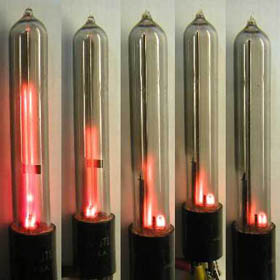![]()
Past and prsesnt, the appearance of a display on any device is a very important factor relating to the purchase of a product. Whether or not the function of the display is essential to the operability of the product is irrelevant. The colors and lighting schemes of digital stereo displays, dashboard lights, appliance control panels, and the like are undoubtedly important factors when marketing a product. Shown here is a small compilation of devices that either led to the development of the magic eye, or mimick the operation of a magic eye.
The "Shadowgraph"
was basically an apparatus similar to an analog meter movement that would cast a shadow on
a small translucent screen. The illustration (right) shows the various elements of
the shadowgraph: A..display screen B..deflecting vane
C..ferrous disc D..permanent magnet E..electromagnetic coil |
|
|
This particular tuning indicator uses a dial lamp as an indicator, where the current flow through the bulb is controlled by a special transformer. The stronger the signal being received, the dimmer the dial lamp gets. |
Gas discharge tubes, primarily neon filled, were the choice for tuning indicators during the 1930's prior to the introduction of the magic eye tube. Inventors experimented with many different electrode configurations in their efforts to make a tube best suited for tuning and resonance indication. This circuit uses a simple three element neon tube in which the neon glow will increase with signal strength. The tube used was known as a Flash-O-Graph, Tune-A-Lite, or Tuneon, depending upon the manufacturer. Atwater Kent was one company to use the Tune-A-Lite, and advertised the feature as "Tonebeam". |
|
 |
A Tune-A-Lite tube illuminated at different levels. Pictures donated by Joe Sousa. New or usable ones are extremely rare, and I haven't been lucky enough to stumble across a new one yet. I have one Tune-A-Lite, and although the tube works, the bulb is blackened on the inside, so the neon glow can only be seen from the tip end. The gas discharge tubes never worked out very well because of sensitivity and consistency limitations, not to mention that the voltage required to energize the bulb is much higher than the voltage at which the bulb becomes extinguished. One radio I own that uses a Tuneon has a three position adjustment on the back of the radio for setting the sensitivity of the indicator. The Tuneon was the UK's version of the Tune-A-Lite, made by G.E.C. of England. |
"Silent Tuning" was an option that would mute noise while tuning in between stations. This was accomplished by a circuit that uses a neon tube similar to the Tune-A-Lite, but with four electrodes. Two electrodes are on top of each other, separated by a small insulator. The stronger the station, the higher the neon glow rises in the tube. When the neon glow reaches the top electrode, the audio stage is enabled. In the early 1930's, Alexander Senauke patented both this and the concept used in the Tune-A-Lite, as well as other vacuum tube designs and functions. |
|
|
The Button Tuneon was intended as a simple tuning indicator, but like other gas discharge devices, there are serious limitations with respect to firing voltage and sensitivity to small changes in potential. These are really nothing more than neon lamps with one halo shaped electrode surrounding a center electrode centered within the halo. I have yet to find a radio that utilizes these. |
This Pioneer reverb had a neat display. Remind you of anything? It was made with ten pieces of glass, each one silkscreened with white ink in an oblong shape, gradually decreasing in size, and a light for each piece. Imagine an oblong 6T5 with ten discrete display levels. |
|
